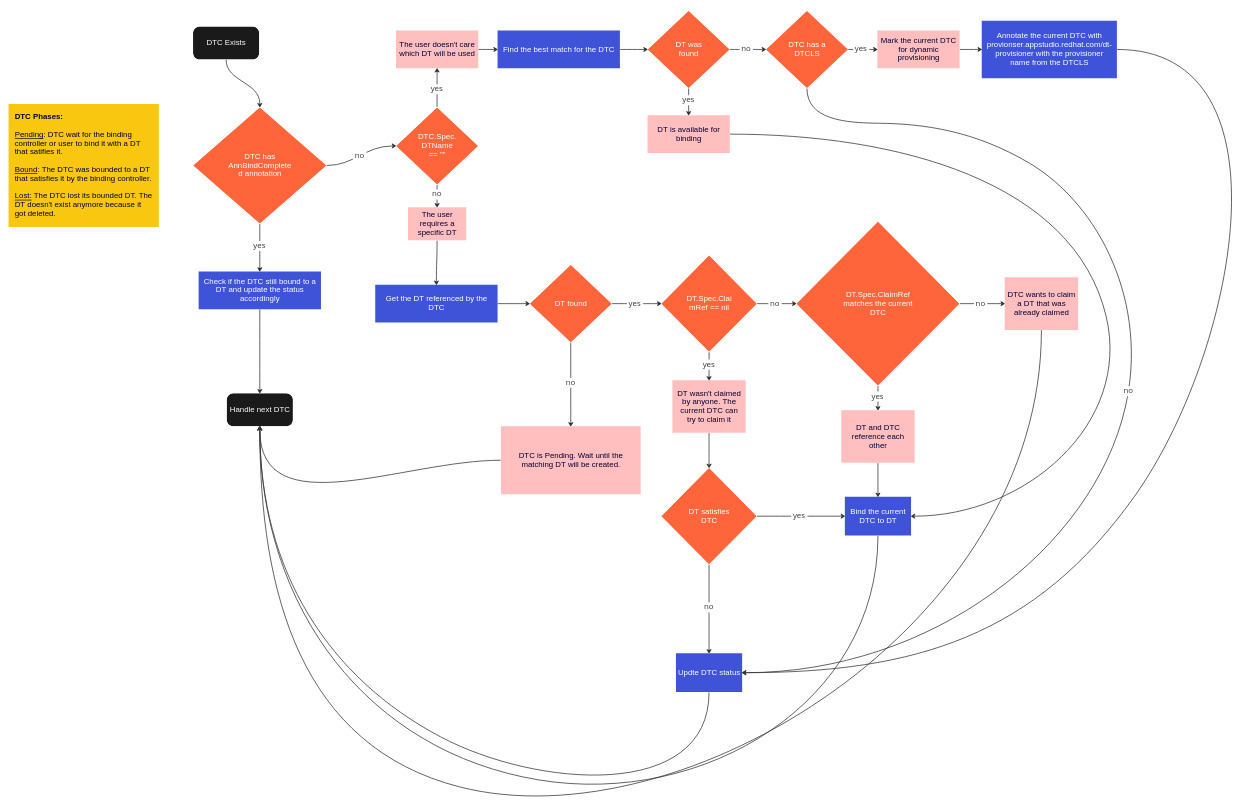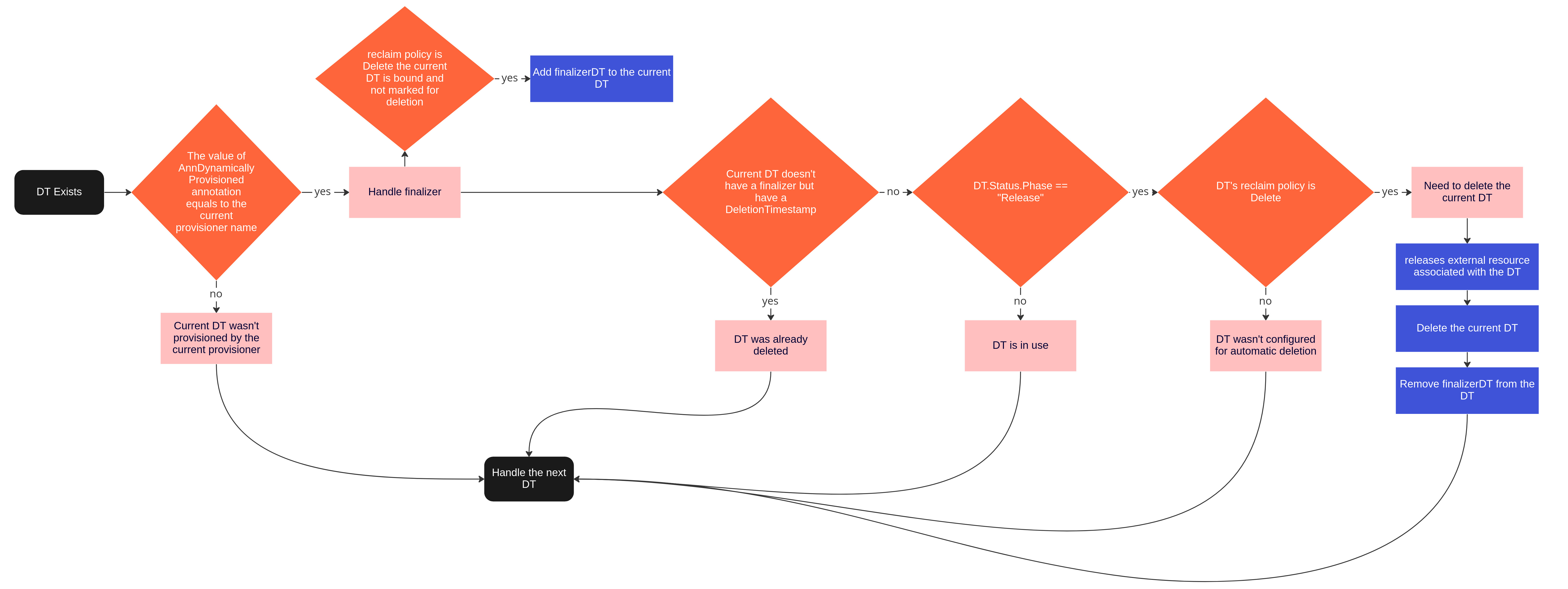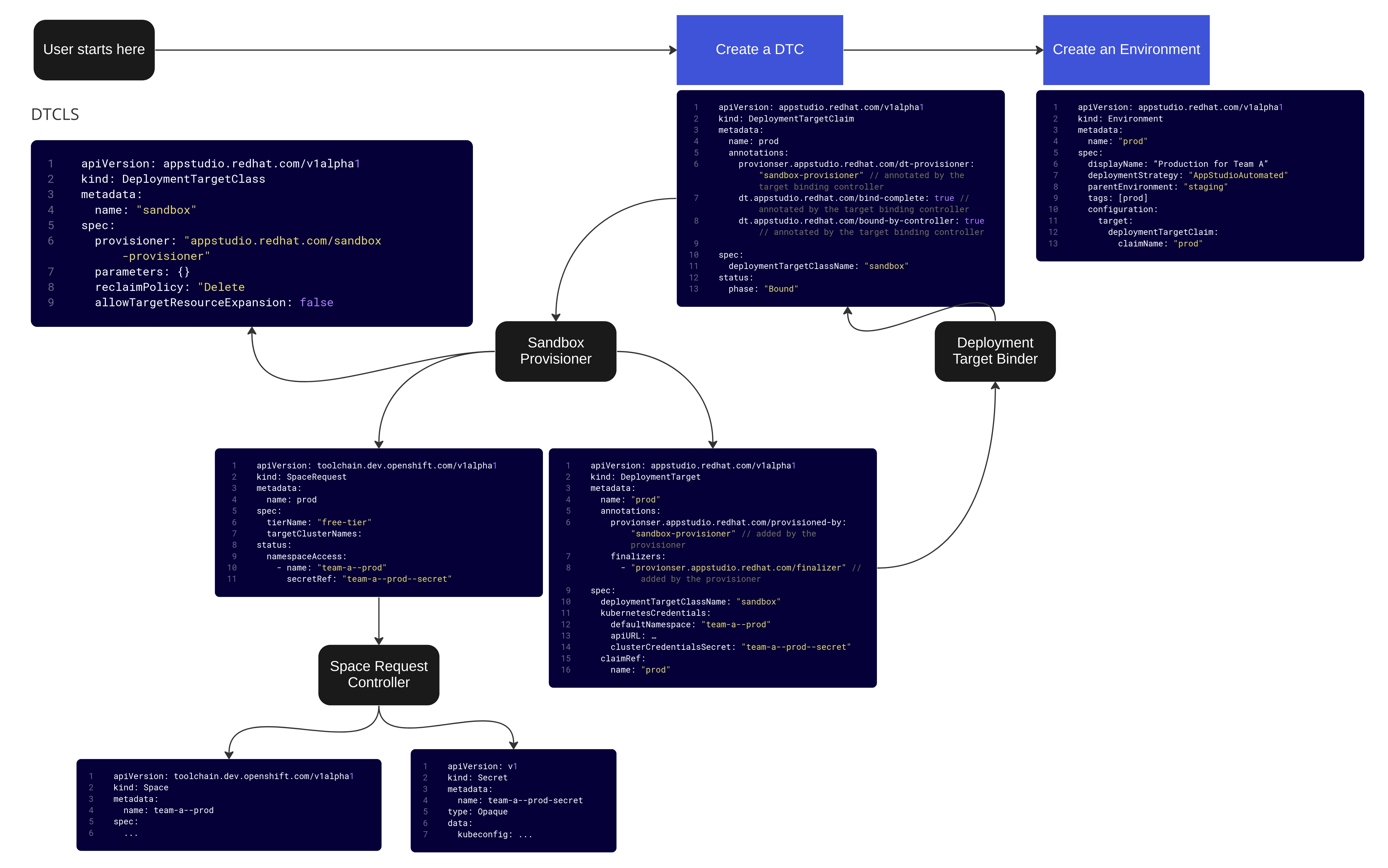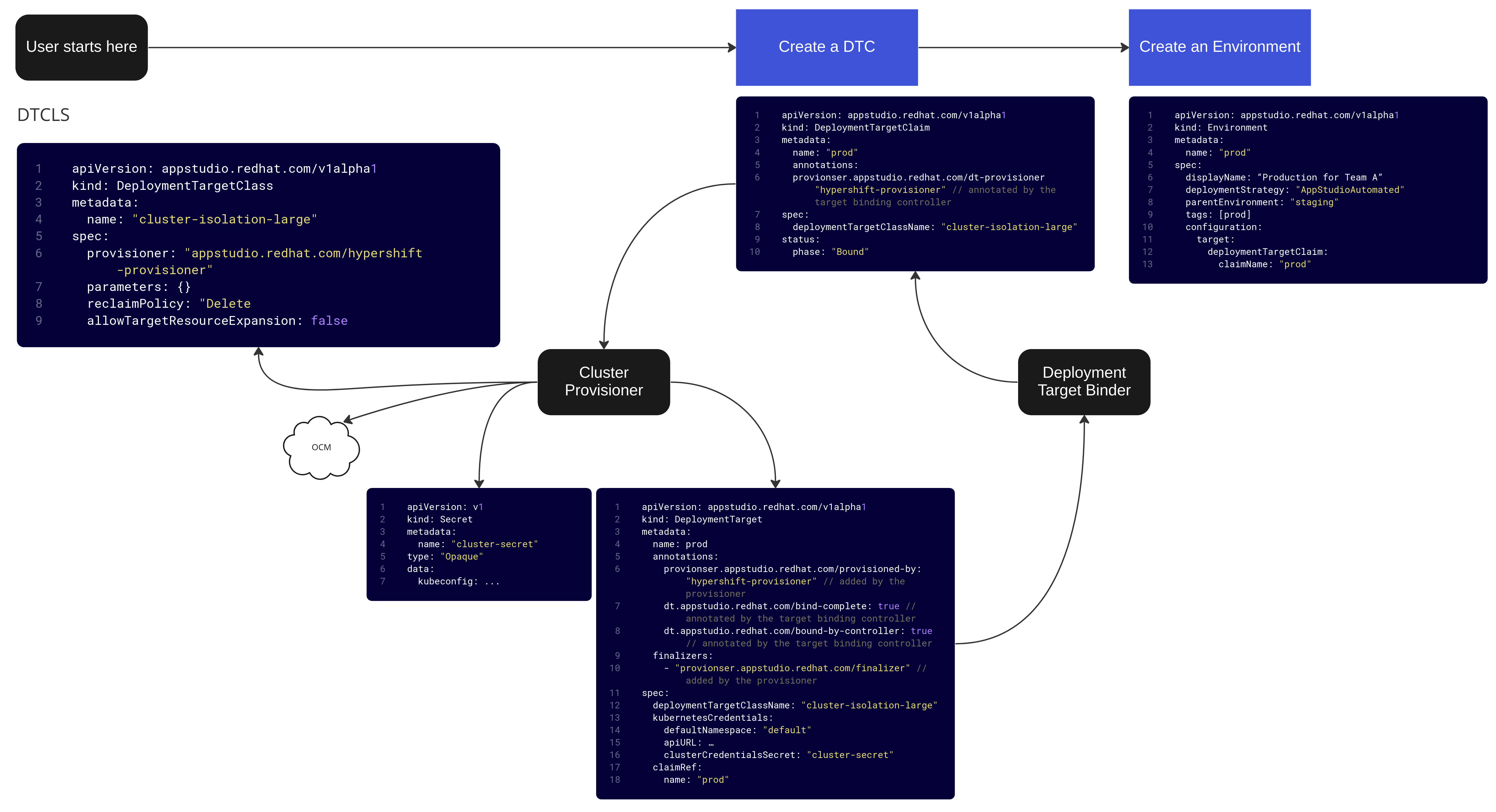8. Environment Provisioning
Date: 2022-12-14
Status
Superceded by ADR 32. Decoupling Deployment
Approvers
- Elson Yuen
- Gorkem Ercan
- Jonathan West
- Shoubhik Bose
Reviewers
- Alexey Kazakhov
- Ann Marie Fred
- John Duimovich
- Krunoslav Pavic
- Scott Hebert
Authors
- Gal Ben Haim
- Ralph Bean
Context
In our old KCP architecture, we had a design for provisioning a new deployment target in support of new Environments. This design was to be implemented in GITOPSRVCE-228 by an environment controller that would create and manage sub-workspaces of the user’s main Konflux workspace, and that would provide a serviceaccount to Argo in order to deploy the user’s application to those sub-workspaces. Now, without KCP, we need a new design.
The Environment CR serves two purposes:
- First, it represents a request from the user for HAS and the GitOps service to recognize a new destination for deployments. A new Environment, when bound to an Application and a Snapshot, causes HAS to write a new directory matching the Environment in the gitops repo, which in turn causes Argo to deploy content from that directory somewhere.
- Second, it represents a request from the user to provision a new deployment target. Back in the KCP design, a new Environment caused the environment controller(s) to create a new sub-workspace, initialize it, and report back a serviceaccount kubeconfig to be used by Argo to administer it.
Some use cases to consider for Environments:
- As a part of the Konflux workspace initialization process, the user should find that both a dev and stage environment with corresponding deployment targets are ready for them (STONE-180). In our post-KCP architecture, these will be backed by namespaces on a devsandbox member cluster.
- The user will want to manually create additional Environments (for example, a prod environment). The user may want to use our compute resources provided in the form of a new namespace on a devsandbox member cluster for this (STONE-183) or they may want to bring their own cluster as a target (STONE-162).
- The integration-service expects to be able to create ephemeral Environments for automated testing purposes (STONE-114). For our short-term goals, the automated testing use case requires the same kind of compute as for the dev and stage Environments (devsandbox member cluster namespaces), but will expand to include other kinds of deployment targets in the future - like hypershift clusters (STONE-185).
Decision
We are going split the two original purposes of the Environment CR into different APIs.
- The Environment will still represent the first purpose of requesting that HAS and the GitOps service recognize a new deployment destination.
- For the second purpose of provisioning a new deployment target we are going to introduce a new DeploymentTarget and DeploymentTargetClaim API, which will be referenced from an Environment.
The new DeploymentTarget API is designed to emulate storage management APIs (see persistent-volumes and storage provisioner design for reference).
CRDs
DeploymentTarget (DT)
A deployment target, usually a K8s api endpoint. The credentials for connecting to the target will
be stored in a secret which will be referenced in the clusterCredentialsSecret field. A DT Can be
created manually by a user, or dynamically using a provisioner. The phase section shows the lifecycle phase of the DT.
Immutable object: no
Scope: namespace
apiVersion: appstudio.redhat.com/v1alpha1
kind: DeploymentTarget
metadata:
name: prod-dt
spec:
deploymentTargetClassName: isolation-level-namespace
kubernetesCredentials:
defaultNamespace: team-a--prod-dtc
apiURL: …
clusterCredentialsSecret: team-a--prod-dtc--secret
claimRef:
name: prod-dtc
status:
phase: Bound
Phases:
Pending: DT is not yet available for binding.
Available: DT waits for a Claim to be bound to.
Bound: The DT was bounded to a DTC.
Released: The DT was previously bound to a DTC which got deleted. external resources were not freed.
Failed: DT was released from its claim, but there was a failure during the release of external resources.
DeploymentTargetClaim (DTC)
Represents a request for a DeploymentTarget. The phase section shows the lifecycle phase of the DTC.
Immutable object: no
Scope: namespace
apiVersion: appstudio.redhat.com/v1alpha1
kind: DeploymentTargetClaim
metadata:
name: prod-dtc
spec:
deploymentTargetClassName: isolation-level-namespace
status:
phase: Bound
Phases:
Pending: DTC wait for the binding controller or user to bind it with a DT that satisfies it.
Bound: The DTC was bounded to a DT that satisfies it by the binding controller.
Lost: The DTC lost its bounded DT. The DT doesn’t exist anymore because it got deleted.
DeploymentTargetClass (DTCLS)
Referred from a DeploymentTarget and DeploymentTargetClaim. Defines DeploymentTarget properties that should be abstracted from the controller/user that creates a DTC and wants a DT to be provisioned automatically for it.
In the example below you can see a class that represents a DT that grants the requestor access to a namespace. The requestor isn’t aware of the actual location the DT is going to be provisioned. The parameters section can be used to forward additional information to the provisioner. The reclaimPolicy field will tell the provisioner what to do with the DT once its corresponding DTC is deleted, the values can be Retain or Delete.
Immutable object: yes
Scope: cluster
apiVersion: appstudio.redhat.com/v1alpha1
kind: DeploymentTargetClass
metadata:
name: isolation-level-namespace
spec:
provisioner: appstudio.redhat.com/devsandbox
parameters: {}
reclaimPolicy: Delete
Environment
Environment objects refer to a DTC using the deploymentTargetClaim
field. The environment controller will wait for the DTC to get to the
bound phase, once it is bound, it will reach the DT and read the
target’s connection details from the kubernetesCredentials field and
configure Argo/Gitops services to use them.
Immutable object: no
Scope: namespace
apiVersion: appstudio.redhat.com/v1alpha1
kind: Environment
metadata:
name: prod
spec:
displayName: “Production for Team A”
deploymentStrategy: AppStudioAutomated
parentEnvironment: staging
tags: [prod]
configuration:
target:
deploymentTargetClaim:
claimName: prod-dtc
Controllers
DeploymentTargetBinder
Binds DeploymentTargetClaim to a DeploymentTarget that satisfies its requirements.
It watches for DTC resources and tries to find a matching DT for each one of them. In addition, it’s responsible for updating the Status sections of the DT and DTC (it also watches DTC objects). It marks DTC objects that requires dynamic provisioning.
A DT that was created dynamically for a specific DTC will always be attached to it.
DT and DTC have one to one bindings.
Binding Loop (DTC Reconciliation)

DeploymentTargetProvisioner
Watch for DTC objects. If the DTC was marked for a dynamic provisioning by the provisioner, it reads the parameters from the [DTCLS] mentioned in the DTC, provisions the target and creates a DT object which references the DTC that started the process.
When a DTC is deleted, if it was bound to a DT created by the provisioner, it reclaims the DT and the actual cluster that was created for it based on the reclaimPolicy configuration.
Provision Loop (DTC Reconciliation)

Deprovision Loop (DT Reconciliation)

EnvironmentController
Watch for Environment objects. If the Environment references a DTC that is Bound and that
DTC references a DT that contains a spec.kubernetesCredentials.clusterCredentialsSecret field,
then ensure that there exists a [GitOpsDeploymentManagedEnvironment] resource that also references
that secret.
DeploymentTarget(DT) and DeploymentTargetClaim(DTC) Lifecycle

Access Matrix
| User,Controller/CRD | DT | DTC | DTCLS | Environment |
|---|---|---|---|---|
| Binder | watch/list/get/update | watch/list/get/update | ||
| Provisioner | create/delete | watch | get | |
| Environment | get | get | watch | |
| Integration | create/delete | create/delete | ||
| User | create/delete | create/delete | create/delete/update |
Annotation details
| Const Name in code | Key | Values | Applied by | Applied on | Purpose |
|---|---|---|---|---|---|
| AnnTargetProvisioner | provionser.appstudio.redhat.com/dt-provisioner | A name of a provisioner | Binding controller | DTC | Indicates that a DT should be dynamically provisioned for the DTC by the provisioner whose name appear in the value |
| AnnBindCompleted | dt.appstudio.redhat.com/bind-complete | “yes” | Binding controller | DTC | Indicates that the binding controller completed the binding process |
| AnnBoundByController | dt.appstudio.redhat.com/bound-by-controller | “yes” | Binding controller | DTC | Indicates that the binding controller bind the DTC to a DT. In practice it means that the controller set the DTC.spec.VolumeName to the value of DT.Name |
| AnnDynamicallyProvisioned | provionser.appstudio.redhat.com/provisioned-by | A name of a provisioner | Provisioner | DT | Indicates that the provisioner whose name appears in the value provisioned the DT. |
Finalizer details
| Const Name in code | Key | Applied by | Applied on | Purpose |
|---|---|---|---|---|
| finalizerDT | provionser.appstudio.redhat.com/finalizer | Provisioner | DT | Delays the deletion of a DT so the provisioner can free up external resources |
Use Case Descriptions
- During onboarding - when a user requests a new appstudio tier namespace, the tier template includes two Environments, and two DTCs. The Environments reference the DTCs. The DTCs bear a request for the
devsandbox[DTCLS]. The devsandbox provisioner responds to that request and generates aSpaceRequest, ultimately resulting in a new namespace for each environment. The spacerequest controller provisions a serviceaccount in the new namespace and places a kubeconfig including the token for this serviceaccount in the origin namespace. TheSpaceRequestin the origin namespace is updated to reference thatSecretand is marked ready by theSpaceRequestcontroller. The devsandbox deployment target provisioner controller sees that and creates the devsandbox DT referencing theSecretand marks the devsandbox DT as ready. The deployment target binder sees that, and attaches the new DTs to the DTCs. The environment controller sees this and creates a [GitOpsDeploymentManagedEnvironment] that references theSecretfound from traversing from the Environment to the DTC to the DT. - For manual creation of new Environments - a user submits a form in HAC which creates a new Environment CR and a new DTC CR. The Environment CR references the DTC CR, which is reconciled as in the previous bullet.
- For automated testing in ephemeral environments - a user specifies an IntegrationTestScenario CR with an existing Environment to clone. After a build completes, but before it executes tests, the integration-service creates a new Environment CR and a new DTC CR with the devsandbox [DTCLS] as above, and references the DTC from the Environment. The integration-service should delete the DTC once the environment isn’t needed anymore for the test.
- BYO cluster - A user creates a DT and a DTC and
Secret. The DT has the details and a reference to the secret used to connect to his/hers cluster. In addition, it contains the name of the DTC it should be bounded to. The user then refer to the DTC from the Environment that should use it.
Manual Environment Creation Examples
Manual Environment Creation - BYOC

Manual Environment Creation - Sandbox

Manual Environment Creation - Cluster

Mutating DeploymentTargets and Claims
Users may mutate existing DeploymentTargets and DeploymentTargetClaims in order to, for instance, request that their provisioned cluster is scaled up to include more resources. However, implementation of resource request changes is provided on a per-provisioner basis. Some may support it, and some may not. Most all of our provisioners in the MVP will make no changes to a DeploymentTarget’s external resources in the event of a resource request change to either the DeploymentTargetClaim or the DeploymentTarget.
In the rare case that a provisioner does support resizing external resources - the user should request resource changes on the DeploymentTargetClaim, which should then cause the provisioner to resize the external resources modeled by the DeploymentTarget. Lastly, the provisioner should update the resources in the spec of the DeploymentTarget to reflect the external change.
Consequences
- Better load distribution between the development teams. An addition of a new provisioner type doesn’t require changing any of the existing controllers.
- Encapsulate the logic of provisioning/deleting a DeploymentTarget within the provisioner that is responsible for it.
- Opens the possibility to create DeploymentTargetClaims in advance and by that reducing the waiting time for an ephemeral environment for testing.
- The design is similar to the design of storage in k8s, so it should look familiar to developers and users.
- We have a larger API surface than we might ultimately need. Users won’t experience this in the UI, but API-based users will face apparent complexity. The fact that this design emulates the concepts in the k8s storage API should reduce the cognitive load this might impose on users and our engineers.
Phases of implementation
An addendum about what features can be left out until later iterations.
Phase 0 (Path to MVP)
For our “MVP” target in early CY23, we’re going to ignore the details of this proposal. It sketches an architecture that we only want to roll out between MVP and Service Preview.
Phase 1
The result of this phase is automation that binds DT and DTC, and automatically provisions an environment on the Sandbox cluster (using the SpaceRequest API) and creates a DT.
- Create the DT, DTC, and DeploymentTargetClass CRDs and make them available.
- Modify the Environment CRD and teach the gitops service how to navigate from the linked DTC to the DT in order to find the Secret that it needs for Argo.
- Implement the binding controller.
- Implement the Sandbox provisioner, to make use of the SpaceRequest API.
- On workspace initialization,
- The NsTemplateTier will:
- Create the Environments for Dev and Stage in the user’s main namespace.
- Create the DeploymentTargetClaims for Dev and Stage in the user’s main namespace.
- The Sandbox provisioner will generate SpaceRequests.
- The SpaceRequest controller should ultimately create namespaces, serviceaccount, and a Secret.
- The Sandbox provisioner in response will generate the DT, linking the Secret.
- The binding controller will bind the generated DT to the DTC.
- The NsTemplateTier will:
Work on the components of Phase 1 (the sandbox provisioner, the binding controller, the gitops service controller changes and the API changes) can all proceed in parallel while work on the SpaceRequest API advances.
When done, Phase 1 enables adjusting the integration service controller to create and delete new Environments and DTCs for integration tests.
Phase 2 (need more grooming and clear requirement from the PM)
The result of this phase is the ability to specify parameters that are needed from the deployment target, such as memory, CPU, CPU architecture and the number of nodes.
- The DT, DTC an [DTCLS] would need to extended to support the new parameters.
- DTCLS - allowTargetResourceExpansion - represents whether or not the underlying provisioner allows targets to be resized. I.e., for a whole cluster provided by the “hypershift” ocm provider - can it have its number or size of nodes increased without having to delete it and create a new one.
- DTC - Immutable object: no, for bound claims, only the resources map can be updated. When updating a resource, its new value can’t be less than the previous value.
- The Sandbox provisioner should be extended to use the properties mentioned above (when those applicable) when creating external resources and a DT.
- The matching algorithm in the binding controller will need to take into account the added parameters.
DeploymentTarget (DT)
apiVersion: appstudio.redhat.com/v1alpha1
kind: DeploymentTarget
metadata:
name: prod-dt
spec:
deploymentTargetClassName: isolation-level-namespace
resources:
requests:
memory: 16Gi
cpu: 8m
limits:
memory: 16Gi
cpu: 8m
arch: x86–64
kubernetesCredentials:
defaultNamespace: team-a--prod-dtc
apiURL: …
clusterCredentialsSecret: team-a--prod-dtc--secret
claimRef:
name: prod-dtc
DeploymentTargetClaim (DTC)
apiVersion: appstudio.redhat.com/v1alpha1
kind: DeploymentTargetClaim
metadata:
name: prod-dtc
spec:
deploymentTargetClassName: isolation-level-namespace
resources:
requests:
memory: 16Gi
cpu: 8m
limits:
memory: 16Gi
cpu: 8m
arch: x86–64
status:
phase: Bound
DeploymentTargetClass (DTCLS)
Hypershift cluster with 3 nodes example:
apiVersion: appstudio.redhat.com/v1alpha1
kind: DeploymentTargetClass
metadata:
name: isolation-level-cluster-small
spec:
provisioner: appstudio.redhat.com/hypershift
parameters:
numOfNodes: 3
reclaimPolicy: Delete
allowTargetResourceExpansion: false
Phase 3
The result of this phase is to automatically provisioning of Hypershift cluster using Konflux’s
credentials. We call it provided compute (compute that we provide, not the user) and it’s included
as part of the offering. This compute can be used for both long lived clusters and for ephemeral
clusters used by the integration service.
For long lived clusters, the maintenance model for them is yet to be determined.
DeploymentTargetClass (DTCLS)
Hypershift cluster with 3 nodes example:
apiVersion: appstudio.redhat.com/v1alpha1
kind: DeploymentTargetClass
metadata:
name: isolation-level-cluster-small
spec:
provisioner: appstudio.redhat.com/hypershift
parameters:
numOfNodes: 3
reclaimPolicy: Delete
allowTargetResourceExpansion: false
Hypershift cluster with 6 nodes example:
apiVersion: appstudio.redhat.com/v1alpha1
kind: DeploymentTargetClass
metadata:
name: isolation-level-cluster-large
spec:
provisioner: appstudio.redhat.com/hypershift
parameters:
numOfNodes: 6
reclaimPolicy: Delete
allowTargetResourceExpansion: false